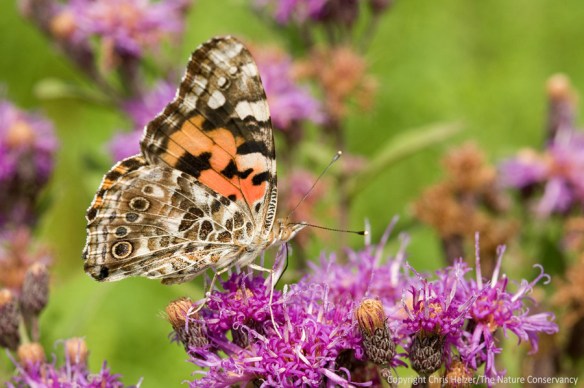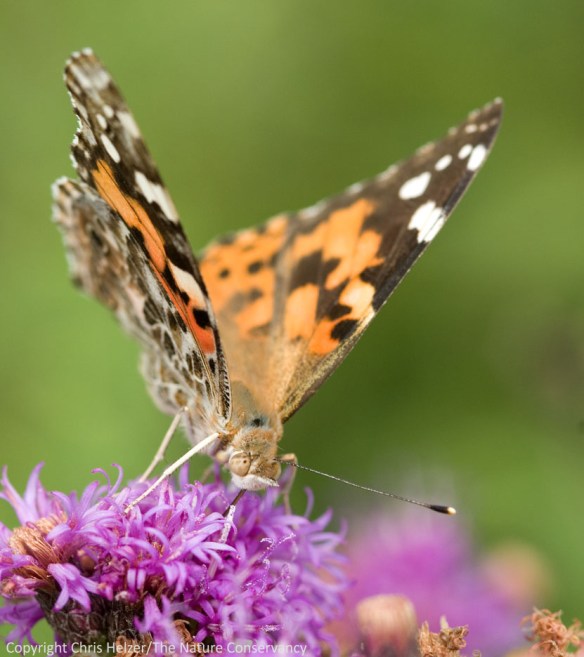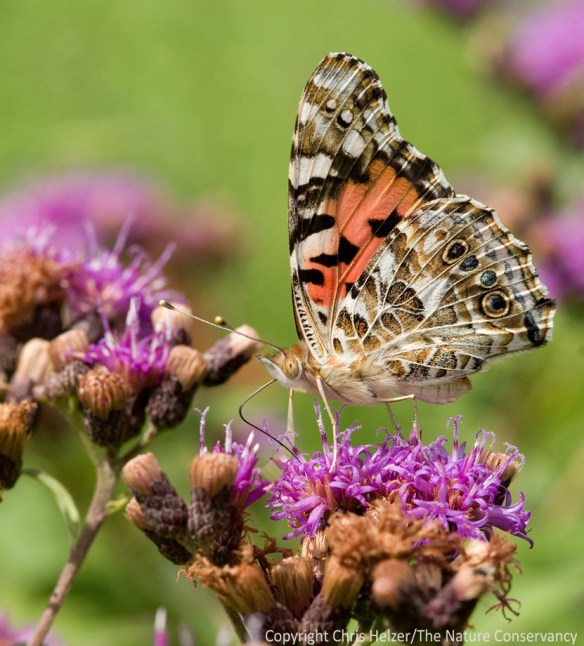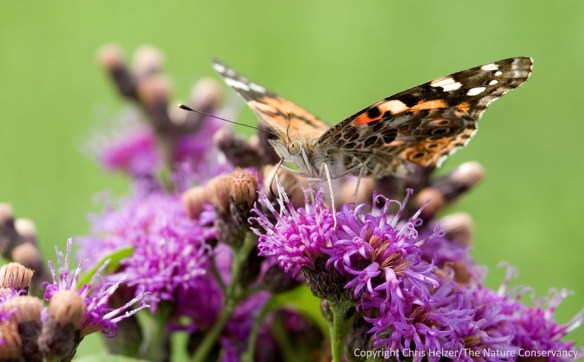I photographed these butterflies (numerous photos below) last weekend at our family prairie. Besides being very pretty, they and the flowers they’re feeding provide an interesting insight into the way biologists sometimes see the world.
Painted lady butterflies are very common and ubiquitous species found on several continents. They’re found equally often in prairies and urban gardens, so they’re considered to be habitat generalists. There’s nothing wrong with painted lady butterflies, but they’re not as exciting for a biologist to see as, say, a Ottoe skipper, which is a rare butterfly that is restricted to native prairies. There’s an extra thrill in seeing a species like that because of their rarity, but also because the presence of specialist species like the Ottoe skipper can be an indication that a prairie has sufficient size and ecological function to maintain even the most sensitive of species. Painted ladies are very pretty, but don’t provide that extra little adrenaline rush for biologists.
The butterflies in these photos are feeding on Baldwin’s Ironweed (Vernonia baldwinii) which is similar to the painted lady butterfly in terms of its abundance and generalist habits. Ironweed is rarely grazed by cattle and so is common in prairies that have been chronically overgrazed to the point where most other wildflowers have disappeared. It also moves across the landscape easily, so it is often found in old fields (crop land left idle) and other “weedy” habitats. Many people, in fact, consider ironweed to be a weed, which isn’t really fair since it’s not aggressive at all – it’s just good at filling open space left by intensive grazing, tillage, drought, and other events that reduce the vigor of dominant prairie plants. While ironweed can exist in prairies that are full of much more specialist and rare plant species, its ability to grow almost anywhere else as well means that its presence is not a good indicator that a prairie is in “good shape” ecologically.
While neither painted lady butterflies nor ironweed are great indicators of whether or not prairies have a full complement of species and ecological processes, both are important components of prairies. Ironweed can provide nectar and pollen, for example, in prairies that are missing most other wildflower species. Similarly, painted lady butterflies can provide some pollination services in prairies that might be missing many other pollinator species. In addition, both species are aesthetically pleasing! Sometimes it can be hard for biologists to remember how valuable generalist species are – and to step back and enjoy their presence, rather than dismissing them as somehow less important or exciting to see than other species. There’s clearly much to be admired about generalists. They’re successful in a world that makes it difficult for many other species to survive. What’s not to like about that?
Some people probably have a hard time understanding why biologists would have this almost dismissive view of generalist species. Here’s my best explanation. Few people would pay to go to a zoo full of species such as squirrels and robins. Those species can be seen almost anywhere. Zoos make money because they can show people species like polar bears, pandas, and crocodiles that can’t easily be found elsewhere. That’s kind of what it’s like for biologists when we see generalist species. It’s not that we don’t appreciate them (I like watching squirrels in my yard – except when they’re stealing apples from my tree) but we see them all the time.
One of the great things about being a photographer, as well as a scientist, is that I get the opportunity to see the natural world from two different perspectives. Each helps balance and inform the other and, I think, makes me better as both a scientist and photographer.
.
.







God’s Glory In Person……….
I always enjoy your photo of the week.
Thanks Julie.
This is a much more eloquent way of putting it than what I am capable of. My wife is always asking me what I’m looking at when I’m staring at the side of the road constantly on road trips, or getting excited about a rare plant or bird sighting at my parent’s house. Good Post!!
Good post Chris.
The painted lady butterfly is nicknamed Cosmopolitan because of its being widespread around the world. It can be found on all continents except Antarctica. This generalist hosts on some 100 different plants, but its favorite is the thistle. Painted lady larvae have even been used as a biological control for some thistle species. As Butterfly Curator at the Lincoln Children’s Zoo, I admit visitors come to see the unique, unusual and rare species, but zoos and nature centers can also feature creatures found in backyard habitats too. I like to be able to show visitors what they can do to increase pollinator habitat in their home landscapes!
I have created my garden with the sole purpose of attracting pollinators. My garden is in Schaumburg, IL. I primarily focus on plants that attract hummingbirds, but I also have many butterfly favorites.
The favorites of my hummingbirds are Penstemon cardinalis, Penstemon eatonii, Lonicera sempervirens, Lonicera ‘Gold Flame’, Lobelia cardinalis, Silene regia, Aesculus parviflora, Monarda didyma, Heuchera sanginea, Columbine canadensis, Buddeleia davidii, Lilium michiganense, Weigelia florida (varieties with small pink flowers) and Hosta. I have also seen them visiting Oenothera biennis (spontaneous in neighbors neglected garden), Syringia vulgaris, and Alcea rosea. The funny thing about the Alcea rosea is they keep visiting the flower spike long after the plant has gone to seed. They must like to eat some insect that is found on Alcea rosea.
The favorites of my butterflies follows. The Monarchs flock to and fight over the Liatris ligulistylis. I have read this Liatris produces a phermone that Monarchs find to be irresistable. The hummingbirds also visit the Liatris, but this plant is definitely evolved for the butterflies. My other butterfly favorites are Buddeleia davidii, Asclepias species, Echinacea species, Phlox species, Silphium species, Clethra alnifolia, Itea virginica, and many plants in the Asteraceae. In local prairies I have noticed Lithospermum canescens is a favorite of Black Swallowtail Butterflies.
However, I digress since this is suppose to be a blog about prairie plants and not gardening. I love the Lincoln Childern’s Zoo. If you want seed or cuttings from any of my plants for the Zoo’s Gardens then give me a call.
James
847 895-9345
You can tell I am a naturalist and a not a scientist because I am thrilled with any one who comes to my yard and partakes of my offerings. I have both iron PLANT (I do not like the name weed)… and painted ladies. I thrill at the unusuals but get just as excited with the regulars. They teach me something every time I see them.
Great pictures Chris
KAREN
Thanks Karen. Actually, there’s a whole ‘nother plant called ironplant (the genus is Haplopappus) – so be careful! Cutleaf ironplant is only found a couple places on our Platte River prairies but is pretty common in mixed-grass prairie.
Yeah…well nobody listens to me…so I call them what I want!!!!!:^)!!!! Common names are a locality/folklore thing any way.
Dad allways called the great blue herons….shy wheel spokes….so I carry on the tradition of naming things as I see ’em:^)!!!(I am an old folk ya know)!!!!
Saw that big ole hawk moth in the moon flowers again this morning but he got away before I could find the camera.
Will keep stalking!
Thanks Chris
We have visitors from California or Europe at the park where I work who are anxious to see a Northern Cardinal. It gives me a renewed appreciation for our common generalist species. Thanks for a good post, Chris.
We have a lot of Monarchs on our northern prairie this summer and I look for a large migration south, much like 2010. I spent a good part of this weekend taking photos, Monarchs and Meadow blazing star.
Like Suzanne’s situation, we had a visitor from France stay with us for two days this summer, who was simply enthralled about monarchs, swallowtails, cardinals, goldfinches, and bluejays in my (leafy & flowery) suburban backyard.
And if it weren’t for common species, I wouldn’t have much to practice my photography skills, in preparation for those rare sightings.
But one thing, Chris, with those appressed phyllaries, I’d be inclined to call that plant Vernonia missurica. What do you think?
Interesting question. As far as I know, we don’t have V. missurica in Nebraska – it’s not in the Flora of Nebraska. We have V. baldwinii and fasciculatum – and they hybridize. Looking at quick internet info on V. missurica, it looks like the leaves are not serrate enough to match what I see at our prairie.
On the other hand, I have a variety of cudweed sagewort (Artemisia luduviciana var. mexicana that isn’t supposed to be in this part of Nebraska – and I assume it was introduced with the grass seeding (from Kansas seed source?). So I can’t rule out V. missurica, but the the leaves just don’t look right.
Leaves are highly variable in this rampantly hybridizing genus — So, maybe the phyllary character could be from introgression from V. fasciculata